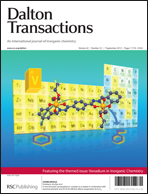The role of vanadium haloperoxidases in the formation of volatile brominated compounds and their impact on the environment
Abstract
Vanadium haloperoxidases differ strongly from heme peroxidases in substrate specificity and stability and in contrast to a heme group they contain the bare metal oxide vanadate as a prosthetic group. These enzymes specifically oxidize halides in the presence of hydrogen peroxide into hypohalous acids. These reactive halogen intermediates will react rapidly and aspecifically with many organic molecules. Marine algae and diatoms containing these iodo- and bromoperoxidases produce short-lived brominated methanes (bromoform, CHBr3 and dibromomethane CH2Br2) or iodinated compounds. Some seas and oceans are supersaturated with these compounds and they form an important source of bromine to the troposphere and lower stratosphere and contribute significantly to the global budget of halogenated hydrocarbons. This perspective focuses, in particular, on the biosynthesis of these volatile compounds and the direct or indirect involvement of vanadium haloperoxidases in the production of huge amounts of bromoform and dibromomethane. Some of the global sources are discussed and from the literature a picture emerges in which oxidized brominated species generated by phytoplankton, seaweeds and cyanobacteria react with dissolved organic matter in seawater, resulting in the formation of intermediate brominated compounds. These compounds are unstable and decay via a haloform reaction to form an array of volatile brominated compounds of which bromoform is the major component followed by dibromomethane.

- This article is part of the themed collection: Vanadium in Inorganic Chemistry

 Please wait while we load your content...
Please wait while we load your content...